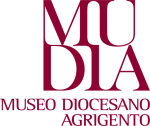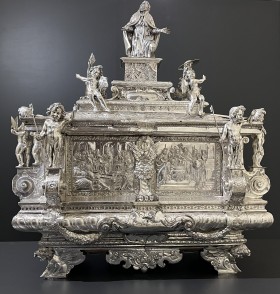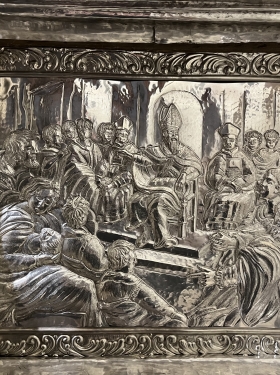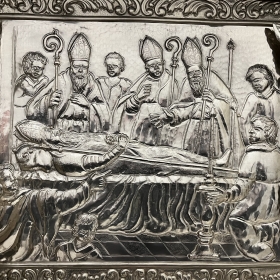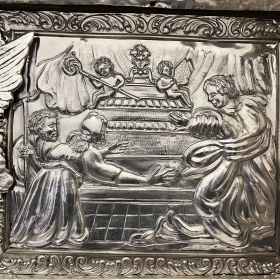A number of works related to the life of Saint Gerlando, some of which are relics and contact relics, have come to the Mudia.
The Urn of Saint Gerlando – an emblematic monument of the Christian faith of Agrigento – testifies not only the deep religious feeling of the people of Agrigento towards the Patron, but also the presence of a cultured and enlightened patronage, that almost always turns to known artists for their execution.
The monumental case was wanted by Bishop Francesco Trayna, head of the Diocese of Agrigento from March 2nd 1627 to October 4th 1651, to enrich the new chapel raised by the same for the Cathedral of Agrigento. On January 10th 1653 Don Francesco Albamonte, procurator of the bishop, commissioned to the Palermitan silversmith Michele Ricca, the exuberant vara, on the project of the abbot Vincenzo Sitaiolo, presenting also the design executed by the great painter Pietro Novelli from Monreale. The cast parts, such as the twelve cherubs, the heads of seraphim and angels were made by the silversmith GiancolaViviano.
The urn was kept, with the reliquary of the co-patron Saint Victoria, in the sacellum of the Chapel of the saint, closed by an embossed copper door with three keys guarded by the bishop, the Chapter and the Jurors of the city. Today, the chapter and bishop's keys are a vital part of the Museum's permanent collection.
The urn was once enriched by six panels that narrated the life of the Saint, now lost after the sacrilegious thefts that have disfigured the harmony. In 2012, the Carabinieri Command for the Protection of Cultural Heritage returned six of the eight putti in the urn. One of the six putti has been included in the permanent collection, completing the section dedicated to the Patron Saint.
Another significant element kept at the Mudia is the relic of the staff of San Gerlando.We owe to Bishop John OroczoCovarruvias (1594-1606) the recovery in 1598 of the wooden urn containing the relics of the holy wooden staff, and therefore contact relics. The Baculus, emblem of the episcopal ministry of the pastor of the diocese, was embellished in 1607 by a silver foil finely embossed and chiseled by the silversmith Matteo Glimpii from Agrigento, and houses a small fragment of the bodily remains of the saint.
